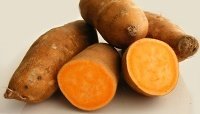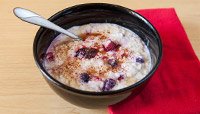The popular "Atkins Diet" used to be known by many as the steak and eggs diet, where you basically ate as much protein and fat as your body could handle while disregarding carbohydrates from your diet and overlooking where your fat was coming from.
People who were following the plan regularly filled their plates with bacon, cheese, high fat meats, mayonnaise - basically anything that was protein and fat. The more the better.
The theory behind this was that because protein and fat are both more satiating, you wouldn't be as hungry and therefore wouldn't take in as many total calories and would see a weight loss. Furthermore, since you weren't supplying your body with any carbohydrates, you would have a higher chance of staying in fat burning mode (since carbohydrates cause an insulin spike and put a halt to fat burning).
The problem however that came about as a result of this diet, was that many people started worrying about their overall health, particularly with respect to heart disease and high blood pressure as it is well known that high saturated fat intakes can aggravate these conditions.
So now, Atkins has revitalized their approach. They are no longer just focusing on foods that are high in protein and fat, but are taking a more well rounded approach to their diet guidelines and touting the importance of healthy carbohydrates and fats combined with protein.
How The Diet Is Laid Out
The Atkins Diet still is composed of four different phases, the first one being the most strict and intended to kick start weight loss while the last one guides you along the path of healthy weight maintenance.
Phase One
The first phase starts you out with a total of only 20 net grams of carbohydrates per day, coming from vegetable sources.
The rules of this phase are basically to include a protein and fat with each meal and keep carbohydrates to the minimum of 20 grams. You are encouraged to drink a lot of water and to really read labels and be on the lookout for 'hidden carbohydrates'.
Generally this phase is followed for about two weeks.
Phase Two
The second phase of the diet is very similar to the first, also emphasizing weight loss, except that now you are going to add 5 grams of net carbohydrates per week to your diet until you have only 5-10 more pounds that you want to lose. The real purpose of this phase is to learn your body's tolerance to carbohydrates and how many and the type you can have while still being successful at weight loss.
The diet does advise that you should be adding low glycemic carbohydrates, such as more vegetables, berries, nuts and cheese to your diet as you gradually increase the total carb count.
Additionally, they state that if you are an avid exerciser, it is a good idea to bring it up to 60-90 grams of carbs per day as your body will need it to maintain the intensity of your workouts.
Phase Three
That brings us to phase three of this diet, otherwise known as pre-maintenance. This stage of the diet is designed to help you learn how you are going to have to eat in order to be able to maintain your weight loss in the future. They instruct you in this stage to start upping your carbohydrate intake by 10 grams a week, rather than the 5 grams per week you did in phase two.
You will keep doing this until your weight loss has stopped and you are now maintaining your weight, or are losing at a very slow weight. This would then be considered your maintenance level carbohydrate intake (called Atkins Carbohydrate Equilibrium - ACE).
They recommend you adding a wider variety of carbohydrates to your diet at this point. That includes such foods as:
 Carrots
Carrots
3/4 cup Yams
Yams
1/4 cup White potatoes
White potatoes
1/4 Peas
Peas
2/3 Beets
Beets
1 cup
 Pinto Beans
Pinto Beans
1/3 cup Kidney Beans
Kidney Beans
1/3 cup Black Beans
Black Beans
1/3 cup Lima Beans
Lima Beans
1/3 Navy Beans
Navy Beans
1/4 cup Lentils
Lentils
1/3 cup
 Oatmeal
Oatmeal
1/2 cup Brown rice
Brown rice
1/3 cup Cereal
Cereal
1/3 cup Semolina pasta
Semolina pasta
1/4 cup
This will no doubt give you much more selection to choose from as far as your food choices go as well as offering you a chance to ensure you are getting all the vitamins and minerals you need for proper long term health.
They also suggest that at this stage of the game, you can start allowing yourself a few higher carb selections once or twice a week but still keeping in mind that it may be wise to cut back your carbohydrate intake the next day to account for these indulgences.
The diet stresses that you must remember that you are not simply going back to your old ways of eating at this time as that is what made you gain weight in the first place and while yes, you are allowed more carbohydrate containing foods at this point, you are still eating a reduced carbohydrate diet and need to remember this so you stay at your new weight.
Phase Four
Finally you complete this diet with stage four, maintenance. At this stage the new Atkins emphases an altered food pyramid than what is set as the standards. Whereas the normal food pyramid has grain products at the bottom, the Atkins has the meat and alternatives group there.
Then next you have your vegetables group, followed by the fruit group, then by the oils, dairy and nuts group and lastly you have your grains group - this being the smallest and what you should choose least often.
They recommend that you weigh yourself once weekly to make sure you are not starting to slip back into your old habits causing you to start gaining weight again and remind you that action should be taken immediately if you are.
Who The Diet Is Good For
This diet works particularly well for those who are already suffering from blood sugar problems such as diabetes or hypoglycaemia. Since you are choosing carbohydrate containing foods that have little effect on insulin levels, it makes it very easy to manage blood sugar levels and keep these conditions in check.
This diet is also great for those who traditionally prefer a more meat based diet as meat is what predominately makes up the diet, however you must be willing to sacrifice back on the amount of fat you are consuming as well (which is the change from the old Atkins thinking).
Who The Diet Is Not Good For
The individuals who this diet may not be the best choice for are those athletes that are involved in a large volume of exercise or those who frequently exercise at a very high intensity. Since high intensity exercise relies pretty much strictly on carbohydrates as fuel, if your stores and intake are low, you are likely to see performance losses and have trouble making it through all your practice sessions.
These individuals can still use some of the approaches practiced by the Atkins diet strategy, such as choosing low glycemic carbohydrates but should also increase their total carbohydrate intake above what this diet is recommending. Anything under one hundred grams of carbohydrates (assuming there are no large weekly carb-up periods) is simply not going to be enough to support the kind of exercise these athletes are expecting of their bodies.
Overall Effectiveness Of The Diet
Since Atkins has changed its approach to dieting, it has become much healthier and is a very suitable diet for long term, healthy weight loss. In today's society people are eating way too many refined foods and this diet basically makes you eliminate them. The carbohydrates you are eating are ones that our early ancestors ate back in the day are most natural in state.
The downside to the diet however, is that you are 'counting' in a sense. While it doesn't say anything about strictly counting calories, the fact you still have to track your carbohydrate grams might make some people feel overwhelmed and want to find a diet that has a looser approach.
Diet Rating: 4/5 - very effective for most people
Recommended For You

3 Vegetables You Need To Eat
Vegetables are the nutritional backbone of a healthy diet. Don't push them to the side of your plate! Make friends with the produce department for better health and performance.
Eat For Anabolism: Pre- And Post-Workout Nutrition For Muscle Growth
Speed up your gains in size and strength by paying attention to the best foods and supplements during your pre- and post-workout nutrition window.







